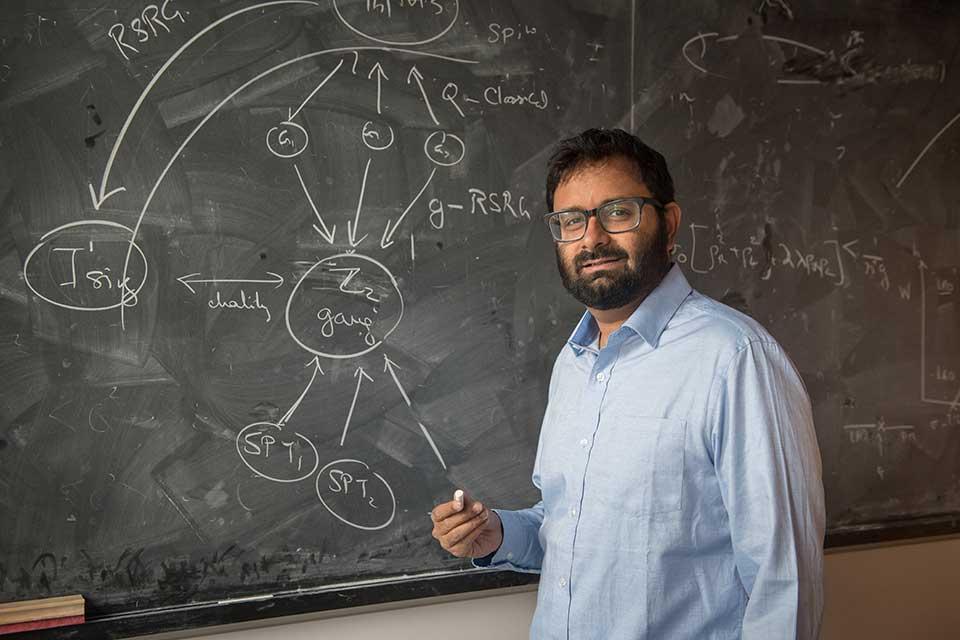Professor Siddharth Parameswaran from the Rudolf Peierls Centre for Theoretical Physics at the Department of Physics, has been awarded a much sought-after European Research Council Consolidator Grant. The funding will help to further his work in theoretically explaining and predicting the emergent phenomena exhibited by quantum many-body systems to guide future experiments. The goal? To create and control new states of quantum matter…
Understanding the behaviour of complex systems built from many strongly-interacting particles is a challenging problem that arises across many fields of science. Even when the microscopic laws governing the individual interactions are very well-understood, often the most interesting properties of such systems are emergent: phenomena that arise at the macroscopic scale, that cannot be understood by simply breaking the system down into its parts. For such problems, there is no "Standard Model"; for each new scale, new ideas and principles are needed – an ethos eloquently summed up by Phil Anderson in a much-celebrated article in Science magazine. Remarkably, however, in many cases the language in which these phenomena are modelled bears a striking resemblance to the theories used in particle physics – a hallmark of the unity of physics, as vividly illustrated by the exchange of ideas in the 1960s between researchers like Anderson working to understand links between superconductivity and what is now called the Higgs mechanism.
My own interests lie specifically in theoretically explaining and predicting the emergent phenomena exhibited by quantum many-body systems: colloquially termed "the many-electron problem", this is made challenging by the fact that quantum mechanics is exponentially complex. For example, when trying to simulate a system of interacting "quantum bits", adding just one more bit doubles the resources required. This complexity both gives quantum mechanics its power – which quantum computers hope to tap – and make quantum problems challenging – where again, quantum computers may prove necessary for a complete solution. Usually, one resorts to approximating systems as "almost" non-interacting, or "almost" in thermal equilibrium, and then uses tools such as perturbation theory and statistical mechanics that are conceptual cousins of the material taught in the standard undergraduate curriculum.
However, increasingly, there are systems where such a non-interacting, near-equilibrium description is insufficient. Sometimes, this is because "weakly interacting" degrees of freedom are absent, or look very different from those in which the problem is phrased microscopically and are hence difficult to guess from first principles. In other cases, systems are driven so far out of equilibrium that we need a new starting point. Much theoretical effort is devoted to understanding such problems. Strikingly, a common theme that has emerged is that two mathematical ideas are powerful organising principles. The first of these is the familiar one of symmetry, but the second, more recent idea is that many interesting problems have topological structure – from that branch of mathematics that focuses on global properties that do not change when systems are smoothly deformed. These ideas, together with ideas from quantum information linked to the entanglement properties of many-body systems, have led to an explosion of theoretical creativity in identifying new and exotic states of matter and novel types of dynamical phenomena. However, these theories can be very difficult to test, because of the lack of controllable platforms for exploring strong interactions, and far from equilibrium dynamics.
A dramatic change
In recent years, however, the situation has changed dramatically with the advent of two new and exciting experimental settings. One class of new platforms are so-called "moiré superlattices": unusual solid-state materials made by stacking atomically-thin layers, that offer the ability to probe many-body phenomena down to the sub-nanometer-scale in a highly tunable setting with strong electron-electron interactions and rich structure linked to the topology of quantum wave functions. The second are "noisy intermediate-scale quantum" (NISQ) computing devices that are also exquisitely controllable simulators of quantum dynamics. Moiré materials are revolutionising progress on traditional solid-state systems characterised by the physics of many particles in thermal equilibrium, while NISQ devices are opening new frontiers in far-from-equilibrium many-body problems. Over the past few years, mathematical ideas and theoretical insights have begun to be exchanged across these fields. The goal of my ERC project is to develop parallel lines of research on both classes of problem and seek synergies between them that will guide a new "convergence" between these frontiers of quantum physics, and thereby guide future experiments towards the goal of creating and controlling new states of quantum matter.
I am particularly excited by the chance to recruit top young scientists as postdoctoral researchers and DPhil students to Oxford, and to host several visitors including for a mid-project workshop that I hope will set the agenda for future work in the field. I was lucky enough to have held an ERC Starting Grant which helped me build up a group from scratch at Oxford, and I am very happy to be able to push forward into new directions without losing momentum thanks to this Consolidator award!

